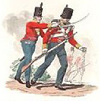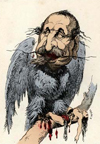| |
| |
EDITO
This week's letter plunges us back 200 years literally into the heart of the Battle of Waterloo, starting with our article of the month, a first-hand account (from the British side) by William Leeke an officer in the 52nd Light Infantry. There is plenty more to read on the subject in our special on Waterloo books, one of which is penned by Robert Kershaw, himself a former soldier, giving him a particular insight into his subject. In a similar way, 150 years ago, another military veteran, the Emperor Napoleon III, who fought at the battles of Magenta and Solferino, proudly published his literary account of one of the first military men, Julius Caesar, to have built an Empire, (and indeed to have written about it!) and in doing so indirectly, but quite deliberately, payed homage to his uncle Emperor Napoleon Bonaparte (another prolific writer), declaring on the one hand: “Caesar disappeared, and his influence predominates still more than during his life”, and on the other: “The ostracism of Napoleon by confederate Europe [was not …] successful in preventing the Empire from being resuscitated…”. And back in today's world, you can learn about the afterlife of the epoch-making battle of Waterloo at the study day in Belgium next month (sign up details below). However, if all that reading seems too much like hard work, why not have a look at how the subject has featured in cinema over the years, in our special on Napoleonic film? You could even watch some on Youtube…
Anyway, as always, enjoy your read here on Napoleon.org
Rebecca Young
Web Editor napoleon.org

|
|
|
| |
ARTICLE OF THE MONTH > THE HISTORY OF LORD SEATON'S REGIMENT, (THE 52ND LIGHT INFANTRY) AT THE BATTLE OF WATERLOO - CHAPTER IV
This month's article is the next instalment of William Leeke's blow-by-blow account of the role played by the 52nd light Infantry at the battle of Waterloo. Leeke (1797–1879) was an officer in Lord Seaton's Regiment as well as a clergyman. His accounts of the Battle of Waterloo are a primary source for many modern historians.
Our article of the month in French, "NAPOLEON III FACE À LA RUSSIE ET LA TURQUIE" can be seen here.

|
|
|
| |
WATERLOO STUDY DAYS
25th February is the last chance to sign up if you want to attend the conference at Waterloo on the 7 March "La Bataille de Waterloo: symbole de victoire, de défaite et lieu de mémoire", organised by the Absl Bataille de Waterloo and the Fondation Napoléon. The event will welcome internationally-acclaimed historians including our own Thierry Lentz and Bruno Colson (winner of the Fondation Napoléon's 2013 Prix Premier Empire) as well as other historians from the Fondation Napoleon and the Musée Wellington…

|
|
|
| |
WATERLOO BOOKS SPECIAL
There are several new books out in time for the 200th anniversary of the battle of Waterloo. We noticed a nice review by Allan Mallinson in The Spectator (external link) which gives a succinct overview of four recent publications: "...If you want Sharpe-like drama, go for Bernard Cornwell. For Eurocentric revisionism, go for Tim Clayton. If you're short of time, there's Brendan Simms's 80-pager. But in a class of its own is former soldier Robert Kershaw making ‘order out of disorder'...". There are literally dozens of other books to check out our Waterloo Reading List including some new publications in Italian, German and French!

|
|
|
| |
NAPOLEONIC FILMOGRAPHIES
Among the incredible resources we have on our website napoleon.org are detailed filmographies of both the First and Second Empires. In our First Empire Napoleonic filmography there are films dating from 1897 and in the Second Empire Napoleonic filmography the list starts in 1923. And for those of you who read Italian, why not have a look at (and download free) Giampaolo Buontempo's very detailed 2-part filmography “Napoleone al Cinema”.

|
|
|
| |
EXHIBITIONS > CARICATURES FROM THE FIRST AND SECOND EMPIRES
The Château de Compiègne is paying homage to the victims of the Charlie Hebdo shootings in January in Paris with a small exhibition revisiting eleven engravings from the Second Empire entitled La Ménagerie impériale (external link in French) which depicted the family of Napoléon III as well as his ministers as animals, until 9th March. Illustration: Napoleon III as a vulture
In London the British Museum focuses its attention on the First Empire and the fascination that Napoleon Bonaparte exercised on the British, and the wonderful drawings that either glorified or ridiculed him. Bonaparte and the British runs until 16th August.
200 YEARS AGO > PREPARATIONS CONTINUE FOR THE ESCAPE FROM ELBA
Taking advantage of the absence of Campbell, 17 February 1815, Napoleon ordered the start of work on his two-masted ship, Inconstant. The Intendant General Balbiani had no trouble recruiting the few dozen workers needed, indeed considering the damage the vessel had sustained, such repair work appeared quite normal (see previous letter).
However, Inconstant alone could not transport the thousand men, the supplies and the horses required for Napoleon's project. So Etoile, a xebec the size of a schooner that the Emperor of Elba had bought, was also discreetly armed, and several other boats were requisitioned, with no resistance from the population, in fact, quite the contrary. The military equipment was taken on board between the 17 and 21 February. Napoleon continued to “act the part”, by approving the hiring of an opera company, ordering the first meeting on the 6 March of the Court of Appeal that he had just formed, and commissioning building work at Portoferraio… whilst secretly planning his means of escape, including a fallback plan to head for Corsica, in case he was intercepted before landing in France. Even his close entourage was not aware of these preparations. Only the spies who watched Napoleon seemed more suspicious and noticed a certain excitement around Portoferraio. They didn't have time to tell their masters, even though the rumour of an escape by the fallen Emperor did reach the French Royalist fleet which prowled even more around Elba. The British had also got wind of the rumours: the unexpected return of Captain Adye, sent by Campbell, the night of 23 February very nearly undermined Napoleon's escape plan. The British Captain, despite the report of his spy Ricci, double checked that Napoleon was still on the island (he left once and returned on the 25…), before departing for Livorno, either unaware of - or simply not realising the importance of - the preparations that were underway…
150 YEARS AGO > PUBLICATION OF THE PREFACE OF HISTOIRE DE JULES CÉSAR BY NAPOLEON III
26 February 1865, the Moniteur Universel published the Preface of the Histoire de Jules César (external link in French) written by Napoléon III, the first volume of which would be officially published on the 1st March. The two-volume work was the result of years of research. The project was not however a simple fantasy on the part of the Emperor. 19th century France saw great renewed interest in the Roman consul who once conquered its land. Napoleon had ordered the “Commission topographique des Gaules” in 1859, partly to provide an answer to the hotly-debated question of the precise location of Alésia mentioned by Julius Caesar in his Commentarii de Bello Gallico (external link in Latin)(“Commentaries on the Gallic War” external link to translation) which divided thinkers in France from 1855 onwards. This archeological study would also provide valuable information for the “History of Julius Caesar” (external link to English translation).
We cannot be sure exactly how much of the history the Emperor actually wrote (he was assisted by numerous experts and scholars such as Mérimée), but it is widely accepted that the preface was written his own words (it is signed from the Palace of the Tuileries on March 20th 1862) and indeed it conveys his ideas that are as much political as historical. Napoleon III's fascination for the Roman Emperor dates back to his youth, he was especially inspired by the publication in 1836 of Précis des Guerres de Jules César (external link in French), dictated by Napoleon 1er during his last years on Saint Helena. As early as 1839 Napoléon III writes about Caesar in a pamphlet L'Idée napoléonienne (whose title and content resembles very closely the introduction to his book Des Idées napoléoniennes published the same year) in which he argues a theory of a succession of men of genius who, across centuries and civilisations, triumph beyond death by their ideas, elevated to the rank of demigods by this “resurrection”. The pamphlet already contained the essential idea expressed in the preface of “A history of Julius Caesar”: the aim of Napoléon III in this work is to use scientific and factual historical study to “prove” the greatness of the personage and ideas of César, and by inference, of Napoleon Bonaparte, (and why not, of Napoleon III himself!) whose empire and influence were to be considered as a natural successor to those of the Roman Emperor. “The aim is to prove that, when Providence chooses such men as Caesar, Charlemagne, and Napoleon, it is to show their peoples the path they ought to follow, to stamp with the seal of their genius a new era, and to accomplish in but a few years the labour of many centuries. Happy the people who understand and follow them!”
Wishing you an excellent Napoleonic week!
Peter Hicks and Rebecca Young
THE NAPOLEON.ORG BULLETIN No. 747, 20-26 FEBRUARY, 2015
Interested in the work of the Fondation Napoléon? Why not participate, either generally or in a specific project, by making a donation?
© This Napoleon.org weekly bulletin is published by the Fondation Napoléon. Reproduction or all or part of this bulletin is forbidden, without prior agreement of the Fondation Napoléon.

|
|
|
|
|
|
|
|
WATERLOO BICENTENARY 1815-2015
What's on this year relating to the Bicentenary of the Battle of Waterloo: commemorations, books, exhibitions, news ...
WATERLOO WHAT'S ON (updated 20/02/15)
-
WATERLOO SEEN ON THE WEB (updated 20/02/15)
WATERLOO READING LIST (updated 20/02/15)
ALWAYS AVAILABLE
Problems with a link in this letter?
- Check the homepage on: http://www.napoleon.org/en/home.asp
- View back numbers of the bulletin: http://www.napoleon.org/en/space/information_bulletin/archive_lettre.asp- Contact us: information@napoleon.org
Follow us on Facebook and on Twitter!
napoleon.org - related content:
JUST PUBLISHED
- GHAZARIANS, Ara (Ed.) and CARPENTER, Catherine (translator):The Memoirs of Roustam Napoleon's Mamluk Imperial Bodyguard (London, 2014)
- WILLMS Johannes, Waterloo: Napoleons letzte Schlacht (Germany, 2015)
WHAT'S ON
Conferences and Talks
- 27 febbraio 1815: Tre donne lucchesi nella grande Storia, (Lucca, Italy) [28/02/2015]
- International Study Day, Waterloo, 7 mars 2015 "La Bataille de Waterloo : symbole de victoire, de défaite et lieu de mémoire" [07/03/2015]
- "Napoleon Hero" lecture by Professor Patrice Gueniffey at Florida State University [02/03/2015]
- Symposium in Lyon, France, 11-12 March, "Napoléon Bonaparte face à l'histoire" [11/03/2015 - 12/03/2015]
- Conference "L'année 1815", Paris [14/04/2015-15/04/2015]
- Napoleonic Historical Society 2015 Annual Conference (Toronto) [28/08/2015 - 30/08/2015]
Exhibitions
- Wordsworth, War and Waterloo, at Wordsworth Museum, Grasmere, Cumbria [16/03/2015 - 01/11/2015]
- Bonaparte and the British: Exhibition at the British Museum [05/02/2015 - 16/08/2015]
- Immaginare la nazione. Saperi e rappresentazioni del territorio a Torino, 1848-1911, exhibition in Turin, Italy [19/12/2014 - 28/03/2015]
- The Battle of New Orleans – The “Other” Battle of 1815, Exhibition at the John Hay Library, Providence [20/01/2015 - 28/03/2015]
- Born for a storm: Andrew Jackson Exhibition (Nashville TN) [08/01/2015 - 28/12/2015]
- Waterloo 1815: A Bicentennial Exhibition at the Hay Exhibition Gallery [16/02/2015 - 25/05/2015]
- Napoleon's Era told through his Medals at the Liechtensteinisches Landes Museum, Vaduz [19/02/2015 - 28/06/2015]
- HMS Victory: The Untold Story is at Historic Dockyard Chatham [14/02/2015 - 31/05/2015]
- From Dirty Shirts to Bucaneers: The Battle of New Orleans in American Culture, Louisiana State Museum [11/01/2015 - 31/12/2015]
- Answering the Call: Tennesseans in the Battle of New Orleans, (Tennessee State Library) [06/01/2015 - 13/04/2015]
- Coaching the Congress Along - Exhibition at the Carriage Museum, Vienna [18/09/2014 - 09/06/2015]
- Cairo to Constantinople: Early Photographs of the Middle East (London, UK) [07/11/2014 - 22/02/2015]
Commemorations
- Le Retour de Napoléon (in Laffrey, France) [06/03/2015 - 08/03/2015]
- Bicentenary of Napoleon's Presence on the Island of Elba [11/04/2014 - 26/02/2015]
WATERLOO WHAT'S ON (updated 20/02/15)
SEEN ON THE WEB (all external links)
- New Iowa tourism ads feature Napoleon (video)
- Civil War Jewish-American Money Revealed
- Battle Of Waterloo Medals To Go Under The Hammer
- Royal Family to honour the 200th anniversary of Waterloo at St Paul's Service
- Three leaders meet at site of the Battle of Three Emperors
- Spontaneous local history Society speaker tells of era of Admiral Lord Nelson and Napoleon.
- Pocket of patriotism: A look inside Gibraltar's Trafalgar cemetery
WAR OF 1812 (external links)
- Historic cemeteries preserved servant graves are marked
- Andrew Jackson: The patriot answered
"WATERLOO" SEEN ON THE WEB (link to our website, updated 20/02/15)
THE BIBLIOTHÈQUE MARTIAL-LAPEYRE FONDATION NAPOLEON LIBRARY
The library is normally open on Mondays and Tuesdays from 1pm to 6pm and on Thursdays and Fridays from 10am to 3pm. The library is closed on Wednesdays.
Special library holiday opening times (16-27 February)
Monday-Tuesday 1pm to 5pm
Thursday 10am to 3pm
closed Wednesday and Friday
Online database catalogue
Digital Library
Contact
NAPOLEONICA LES ARCHIVES
Site of digitised Napoleonic archival material:
The working papers or 'imprimés' of the Napoleonic Conseil d'Etat, the correspondence of Vivant Denon, etc.
http://www.napoleonica.org
Contact: napoleonica@napoleon.org
NAPOLEONICA. LA REVUE
International peer-review interdisciplinary e-review on the history of the two Empires, bilingual French-English, 3 issues per year, free access.
Read the review on Cairn.info
Contact: napoleonicalarevue@napoleon.org
ACCOUNT DETAILS
To change your email address, unsubscribe, and sign up for the French information bulletin.
|
|






